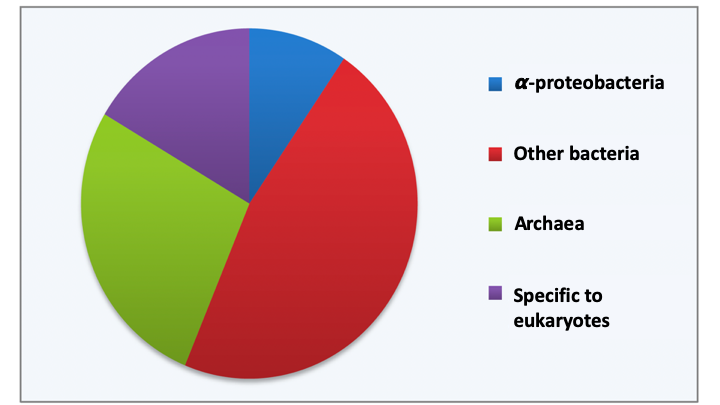Genomic signatures
Back to main indexGenomes contain traces of the history of organisms. Their analysis should therefore make it possible to some extent to trace this history. Comparisons of proteins with the same functions and the same ancestor in the three extant domains, or orthologous proteins, show that the genomes of eukaryotes contain a mosaic of genes: some code for proteins more related to those of eubacteria, others to archaeal proteins and the rest to proteins which appear to be specific for eukaryotes (Figure 17). It is possible to define two main classes of genes according to their role in cell physiology: genes involved in the expression of information, called informational genes, such as genes involved in translation, transcription, replication, plus GTPases and vacuolar ATPases, and genes involved in metabolism, called operational genes such as those involved in the synthesis of amino acids, cofactors, nucleotides and lipids, and those involved in energy metabolism or encoding envelope proteins. Comparisons show that eukaryotic informational genes in general closely resemble those of archaea, while operational genes tend to resemble those of eubacteria. As for the genes absent in prokaryotes, they code, as expected, for proteins involved in specific processes in eukaryotes: establishment of the cytoskeleton, endocytosis/phagocytosis, but also signal transduction via calcium and G proteins, nuclear proteins like histones, nuclear pore and splicing proteins, and more unexpectedly ribosomal proteins and some enzymes. The prokaryotic genome which currently contains the most genes typically present in eukaryotes and usually absent in prokaryotes is that of archaea of the genus Lokiarchaeum. These uncultivated organisms were discovered in 2015 via their DNA in marine sediments near hydrothermal vents, and form the lineage of Lokiarchaeota. The genome of these organisms contains genes encoding actins, certain components of the ESCRT machinery involved in the management of vesicular trafficking and small G proteins involved in cell division.

Figure 17.
Comparison of eukaryotic proteins with those of other living domains. Each portion of the pie chart is proportional to the fraction of eukaryotic proteins most closely resembling the group indicated.These analyzes therefore show that the eukaryotic genome is formed from genes originating from eubacteria, archaea and genes which may have appeared during the evolution of the eukaryotic cell. There are therefore two questions:
- What is the relationship between eubacteria, archaea and eukaryotic cells?
- How did the characteristic attributes of eukaryotic cells appear?
The answers to these questions are clear: we do not know them! The nature of the ancestor of eukaryotes is unknown and its description is still speculative today because no clear fossil trace of the first eukaryotic cells remains. Nevertheless, all the data suggest an early appearance of eukaryotes, or of their ancestor, the “proto-eukaryotic” cell, and therefore potentially a very long evolutionary history, probably from at least two precursors: an archaea and an eubacterium. How exactly this occurrence happened is still a mystery and the next chapter will present some hypotheses.
Back to chapter index